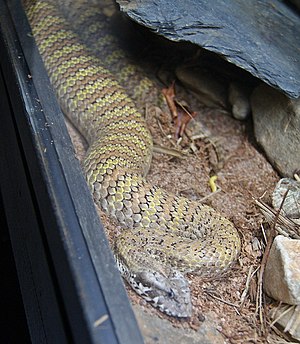Northern death otter
| Northern death otter | ||||||||||||
|---|---|---|---|---|---|---|---|---|---|---|---|---|

Northern death adder ( Acanthophis praelongus ) |
||||||||||||
| Systematics | ||||||||||||
|
||||||||||||
| Scientific name | ||||||||||||
| Acanthophis praelongus | ||||||||||||
| Ramsay , 1877 |
The northern death adder ( Acanthophis praelongus ) is a species of snake from the family of poisonous snakes (Elapidae) and belongs to the genus of the death adder ( Acanthophis ). The first scientific description was made by the Australian zoologist Edward Pierson Ramsay in 1877.
features
Acanthophis praelongus reaches a total length between 40 cm and 70 cm. The body is strongly built. The head is relatively flat, broad and clearly set off from the neck. The eyes have a rounded pupil that is vertically elliptical when exposed to light. The tail is short, thin, and can be brightly colored. The upper side of the body has a basic color that varies depending on the individual and can range from gray to dark brown to reddish brown. There are around 50 light, dark-edged cross bars along the body. The head is colored dark. The shields of the upper and lower lips have a light border and can have a striking pattern of spots. As is typical for venomous snakes, the venom apparatus consists of venom glands located on the side of the skull (specialized salivary glands ) and fangs located in the anterior upper jaw (proteroglyphic tooth position).
The pholidosis (scaling) shows the following characteristics:
- 21 to 23 rows of trunk scales ( Scuta dorsalia ),
- mostly less than 130 abdominal shields ( scuta ventralia ),
- 1 undivided anal shield ( scutum anale ).
Similar species
Acanthophis praelongus is closely related to Acanthophis antarcticus (common death adder). It can easily be confused with this one and Acanthophis pyrrhus . The following features can be used to differentiate:
- In contrast to A. pyrrhus darker color, more pronounced color pattern, posterior scuta dorsalia smooth or almost smooth, prefrontals undivided.
- In contrast to A. antarcticus head shields wrinkled, anterior dorsal scuta more keeled, free edge of the supraocular shields often raised, 4th sublabial scutum not much higher than wide and usually fewer rows of dorsal shields on the neck than on the back.
distribution
The distribution area includes regions in Indonesia ( Seram , Tanimbar Islands , Western New Guinea ), Papua New Guinea and Australia ( Northern Territory , Queensland , Western Australia ). The populated biotopes are represented by savanna-like plains and grasslands, embankments, tropical rainforests and bushland.
Way of life
Acanthophis praelongus leads a nocturnal, hidden and ground-dwelling way of life. Most of the time it spends the day buried in the soil, for example under rotting leaves. As a hide hunter, she waits for prey to pass by. The eyes peek out from the substrate and the worm-like tapered tip of the tail is mostly stuck out of the substrate near the head. The bright color and twitching movements imitate a potential prey in order to attract lizards (the main food of the northern death otter) or small birds. These are grabbed by a quick bite of the snake when they get close enough. Frogs are also preyed on . The northern death otter is threatened by the spread of the cane toad , which is also not spurned, but is poisonous. The propagation is done by ovoviviparity , so egg-viviparous. Litters with a little less than ten young snakes have been documented in captivity. The young snakes measure around 10 cm at birth.
When approaching, the snake usually remains motionless and relies on its camouflage. If it is still disturbed, it goes into a defensive position with a flattened body and curled body loops and, if necessary, hits with lightning speed with a defensive bite. Finally she tries to escape.
Snake venom
The poison secretion of Acanthophis praelongus contains primarily presynaptic and postsynaptic neurotoxins . Furthermore, myotoxins and substances with an anticoagulant effect are presumably present. When poison secretions were removed (milking), a yield of 49.5 mg (dry weight) was determined. In addition to non-specific general symptoms (e.g. headache, dizziness, nausea, vomiting) and slight pain at the bite site, neurotoxic symptoms are in the foreground. Symptoms of paralysis can initially manifest themselves as ptosis and eventually lead to paralysis . Death can result from peripheral respiratory paralysis . The most important measure after intoxication by poison bite is the application of a suitable antivenin (e.g. 'Death Adder Antivenom' or 'Polyvalent Snake Antivenom (Australia - New Guinea)' from the manufacturer CSL Limited ) as part of intensive care.
Individual evidence
- ↑ a b Acanthophis praelongus in The Reptile Database (accessed July 1, 2018)
- ↑ a b University of Adelaide, Clinical Toxinology Resources: Acanthophis praelongus (accessed July 1, 2018)
literature
- Ludwig Trutnau: Snakes in the Terrarium Vol. 2: Poisonous snakes . Verlag Ulmer, Stuttgart 1998, ISBN 3-800-1705-23 .
- Swan - The Australian Museum: A Photographic Guide to Snakes & other Reptiles of Australia . Tien Wah Press (Pte) Ltd, 1996, ISBN 185368-585-2 .
